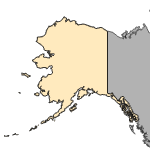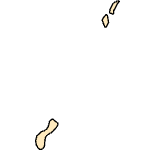Cherax quadricarinatus
(Australian redclaw crayfish)
Crustaceans-Crayfish
Exotic |
|
Common name: Australian redclaw crayfish
Synonyms and Other Names: Queensland Redclaw Crayfish, Tropical Blue Crayfish, Freshwater Blueclaw Crayfish, North Queensland Yabby, Blue Lobster, Redclaw Crayfish
Taxonomy: available through
www.itis.gov
Identification: Cherax quadricarinatus is a large bodied crayfish with a blue-green to green color with red and maroon highlights. Adult males have a soft, fleshy, bright red patch on the outer margin of the major chelae. This species also has four long and distinct carinae (ridges) on the dorsal surface of the cephalon (Coughran and Leckie 2007).
Size: Cherax quadricarinatus may reach a total length of about 250 mm (9.8 inches) and weigh up to 600 grams (21.2 oz) (Ahyong and Yeo 2007)
Native Range: Cherax quadricarinatus is native to Australia, and can be found in freshwater creeks and water bodies in tropical Queensland, the Northern Territory and southeastern Papua New Guinea (Coughran and Leckie 2007).



|

Alaska |

Hawaii |

Puerto Rico &
Virgin Islands |

Guam Saipan |
Hydrologic Unit Codes (HUCs) Explained
Interactive maps: Point Distribution Maps
Nonindigenous Occurrences:
Cherax quadricarinatus is established in Puerto Rico. Multiple farms had stocked the species in earthen ponds in northeastern Puerto Rico without local Natural Resource Management’s knowledge. Adults of the crayfish were discovered to have escaped after Hurricane George hit Puerto Rico on 09/22/1998. The species is now established in the Loiza River and Carraizo Reservoir. C. quadricarinatus has maintained its numbers and is now expanding its range in Puerto Rico (Williams et al. 2001). Additional feral populations have been established in South Africa, Mexico, Jamaica, and Singapore (Ahyong and Yeo 2007)
Table 1. States with nonindigenous occurrences, the earliest and latest observations in each state, and the tally and names of HUCs with observations†. Names and dates are hyperlinked to their relevant specimen records. The list of references for all nonindigenous occurrences of Cherax quadricarinatus are found here.
Table last updated 12/19/2025
† Populations may not be currently present.
Ecology: Cherax quadricarinatus is tolerant of a wide variety of habitats can be found in tropical and subtropical climates coastal streams and freshwater environments, with a preference for the slower moving upper reaches of rivers as well as lakes and lagoons (Wingfield 2002). Cherax quadricarinatus is a non-burrowing species that is tolerant of high temperatures and relatively low dissolved oxygen concentrations (Masser and Rouse 1997). Similar to North American crayfish species, Cherax quadricarinatus is an omnivorous detritivore, feeding on plant and animal decay. However, unlike native crayfish, the species does not rely on environmental cues for seasonal breeding, such as temperature changes, but instead, can breed all year, with multiple broods being produced in water temperatures above 75 °F. Cherax quadricarinatus reaches sexual maturity before one year of age, with females producing up to 1000 eggs and 3-5 broods during a breeding season (Masser and Rouse 1997).
Cherax quadricarinatus exihibits the traits of both r- and K- selected species, with its life history including high numbers of offspring with low mortality rates and large body sizes, likely promoting the species' successful colonization in many areas outside of its native range (Beatty 2005).
Means of Introduction: This species has high growth rates and tolerance to wide variations in water quality making it suitable for aquaculture (Anson and Rouse 1994; Coughran and Leckie 2007). In Puerto Rico, the species was introduced by aquaculture escapes (Williams et al., 2001). The hardiness and colorfulness of C. quadricarinatus has also make it popular in the aquarium trade, making aquarium dumps a possible means of introduction (Ahyong and Yeo 2007; Coughran and Leckie 2007).
Status: Established via aquaculture escape in Puerto Rico (Williams et al. 2001). Established near the Rio Grande in southern Texas (Sanjar et al. 2023).
Impact of Introduction: Summary of species impacts derived from literature review. Click on an icon to find out more...
Cherax quadricarinatus is aggressive and possibly constitutes a threat to native Puerto Rico freshwater shrimps (Williams et al. 2001). This species has the potential to impact native fauna through direct competition, predation or habitat modification (Ahyong and Yeo 2007). Cherax quadricarinatus has also been reported to be a carrier of a number of pathogens, including viruses, bacteria, fungi, protozoan and metazoan parasites that could spread to native crayfishes and shrimps (Ahyong and Yeo 2007; Austin et al. 2009).
References: (click for full references)
Ahyong, S. T., and D.C. Yeo. 2007. Feral populations of the Australian red-claw crayfish (Cherax quadricarinatus von Martens) in water supply catchments of Singapore. Biological Invasions. 9(8): 943-946.
Anson, K. J., and D.B. Rouse. 1994. Effects of Salinity on Hatching and Post-Hatch Survival of the Australian Red Claw Crayfish Cherax quadricarinatus. Journal of the World Aquaculture Society. 25(2): 277-280.
Austin, C.M., C. Jones and M. Wingfield. 2009. Cherax quadricarinatus. In: IUCN 2011. IUCN Red List of Threatened Species. Version 2011.1. Available: www.iucnredlist.org.
Accessed October 2011.
Beatty, S.J. 2005. Translocations of freshwater crayfish: contributions from life histories, trophic relations and diseases of three species in Western Australia. Unpublished Ph.D. dissertation. Murdoch University, Perth, Western Australia.
Coughran, J., and S. R. Leckie. 1997. Invasion of a New South Wales stream by the tropical crayfish, Cherax quadricarinatus (von Martens). Pest or Guest: the zoology of overabundance:40-46.
FAO. 2011-2013. Cultured Aquatic Species Information Programme. Cherax quadricarinatus. Cultured Aquatic Species Information Programme. Text by Jones, C. In: FAO Fisheries and Aquaculture Department [online]. Rome. Updated 13 January 2011. [Cited 6 September 2013], http://www.fao.org/fishery/culturedspecies/Cherax_quadricarinatus/en.
Masser, M.P. and D.B. Rouse. 1997. Australian red claw crayfish. Southern Regional Aquaculture Center. SRAC Publication No. 244. 8 pp.
Medley P.B., R.G. Nelson, L.U. Hatch, D.B. Rouse, and G.F. Pinto. 1994. Economic feasibility and risk analysis of Australian red claw crayfish Cherax quadricarinatus aquaculture in the southeastern United States. Journal of the World Aquaculture Society, 25(1):135-146
Rubino, M., N. Alon, C. Wilson, D. Rouse and J. Armstrong. 1990. Marron aquaculture research in the United States and the Caribbean. Aquacult. Mag. 16(3):27-44
Williams, E.H., Jr., L. Bunkley-Williams, C.G. Lilyestrom and E.A.R. Ortiz-Corps. 2001. A review of recent introductions of aquatic invertebrates in Puerto Rico and implications for the management of nonindigenous species. Caribbean Journal of Science 37(3-4):246-251.
Wingfield, M. 2002. An overview of the Australian freshwater crayfish farming industry. Freshwater Crayfish 13: 177-184.
Author:
Daniel, W., Boucher, N., Elgin, A., Shelly, C.
Revision Date: 12/19/2025
Citation Information:
Daniel, W., Boucher, N., Elgin, A., Shelly, C., 2025, Cherax quadricarinatus (von Martens, 1868): U.S. Geological Survey, Nonindigenous Aquatic Species Database, Gainesville, FL, https://nas.er.usgs.gov/queries/FactSheet.aspx?speciesID=220, Revision Date: 12/19/2025, Access Date: 12/19/2025
This information is preliminary or provisional and is subject to revision. It is being provided to meet the need for timely best science. The information has not received final approval by the U.S. Geological Survey (USGS) and is provided on the condition that neither the USGS nor the U.S. Government shall be held liable for any damages resulting from the authorized or unauthorized use of the information.